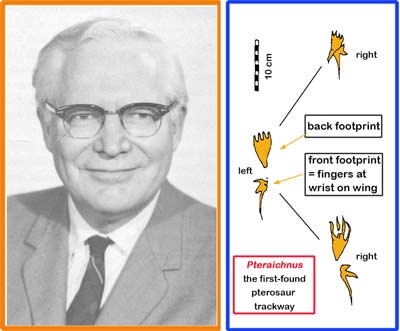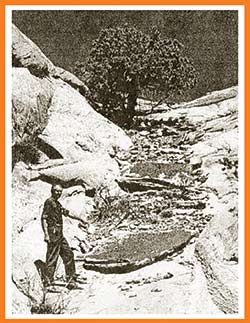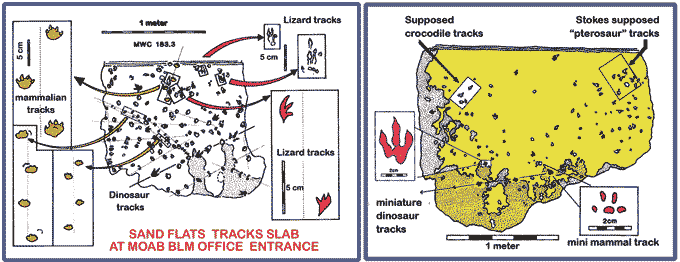 |
| William Lee Stokes, famous Utah Geologist, discovered the first pterosaur tracks ever discovered from Late Jurassic rocks in the Four Corners area. They proved that pterosaurs walked on all fours. The alternate crocodile trackmaker theory proved wrong. Portrait courtesy of Utah Geological Survey. |
If you are born in a coal mining camp, in Carbon County you may be destined to become a geologist. This was certainly the case for one William Lee Stokes who was well known to all notable Utah geologists of his generation. Collaborating with such notables he produced the first geological map of Utah, a best-selling text book (Essentials of Earth History) which went through four editions and sold 150,000 copies in all fifty states. His solo effort Geology of Utah was described as an ‘instant success.’ Although known for his broad-based geological expertise Stokes (1915-1994) made valuable contributions to paleontology. One might even say he had a knack for picking on important topics that were interesting and a little controversial.
One enduring Stokes contribution was his naming, in 1957, of Pteraichnus saltwashensis (meaning pterosaur tracks from the Salt Wash member of the Morrison Formation): age Late Jurassic. This was the first correctly identified pterosaur trackway ever discovered. In the 1980s and 1990s controversy raged as two trackers (one from UC Berkeley and one from Columbia University) claimed the tracks were made by crocodilians, because they believed pterosaurs were bipedal. By the mid-1990s the east and west coast were proved wrong, and Stokes was correct in proving pterosaurs were quadrupedal. Happily, just before he passed away, I told him trackers agreed he was right.
Step back to Moab in the late 1960s. Lin Ottinger of Rock Shop fame finds two large, twin, 1-2 ton slabs covered with small tracks in the Lower Jurassic Navajo Sandstone in the Sand Flats area. In his 1997 book Dinosaur Tracks and Trackers, Moab resident Fran Barnes shows Lin standing beside his discovery and wrote that by then “The resident
 |
Historic photo (circa 1968) of Moab resident
Lin Ottinger pointing to the two Early Jurassic track slabs he discovered in the Sand Flats area. Photo modified from original by Fran Barnes |
specialist on pterodactyl tracks …is Professor Stokes.” Stokes wrote to Barnes that it was “almost comical the number of people who now have an interest” in this intriguing find. Sure, why not, pterosaurs are cool! Long story short: Barnes devotes 15 readable pages and 20 photos to the story of collecting, rubber molding and describing these tracks. The famous Utah paleontologists mentioned and photographed include Stokes, his friend Jim Madsen (co-researcher for years on the Cleveland Lloyd Allosaurus quarry) and Jim Jensen (March 2022 Moab Happenings).
As it turns out the Sand Flats tracks were not made by pterosaurs. Again, long story short the alternate crocodile interpretation of east and west coast experts was also wrong. It turns out the tracks were made by small cat-sized proto mammals, small bird sized dinosaurs, and possibly lizards. The good news is that the slabs, one today on view outside the BLM office in Moab, reveal a variety of interesting tracks made around a waterhole in the Early Jurassic desert. The bad news is that Stokes was not correct twice. Pterosaurs did not frequent ~190-million-year-old Early Jurassic desert oases and, based on tracks, only arrived in North America ~30-40 million years later in the Late Jurassic, mostly along seacoasts. Stokes originally report a dozen tracksites in the Navajo Formation, across Utah from Idaho to Arizona, proving the region was not a lifeless desert environment. He paved the way for Fran Barnes and the present generation of local trackers to report the 100 + tracksites now known.
As a FOOTNOTE, no pun intended, Stokes challenged creationist claims of 500-million-year-old human footprints from Age of Trilobites strata in Millard County, Utah. Two of his last four papers were in the Journal of Geological Education dealing with “Creationism and the dinosaur boom” of the 1980s.
 |
| The twin Sand Flats track slabs found by Moab resident Lin Ottinger are evidence of the activity of abundant, small, Early Jurassic mammal relatives and bird-sized dinosaurs, as mapped and published by the author in various sources. The interpretation of some tracks as crocodilian or pterosaurian has been refuted. One slab is on display at the BLM office. |
|